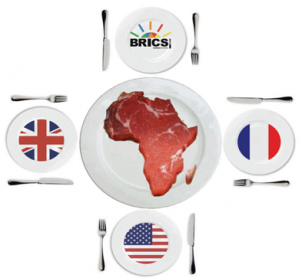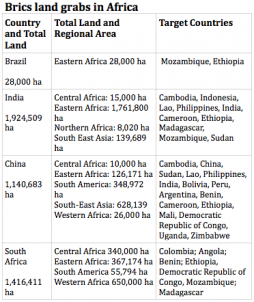FIFTH
BRICS SUMMIT
Durban, South Africa
26 - 27 March 2013
BRICS and AFRICA: Partnership for Development, Integration and Industrialisation
South Africa’s President Jacob Zuma hosted the Fifth BRICS Summit on 27 March 2013 in Durban under the theme: “BRICS and Africa: Partnership for Development, Integration and Industrialisation.” This Summit completed the first cycle of BRICS Summits and was the first time that the Summit was hosted on the African continent. This has specific relevance given that it coincides with the 50th anniversary celebrations of the Organisation of African Unity/African Union (AU).
South Africa’s projected outcomes for the Fifth BRICS Summit were achieved.
- The BRICS Leaders agreed to the establishment of a New Development Bank and indicated that the initial capital contribution to the bank should be substantial and sufficient for the bank to be effective in financing infrastructure.
- In addition, the Leaders also agreed on the establishment of the contingent reserve arrangement (CRA) with an initial size of US$100 billion. The CRA would help BRICS countries forestall short-term liquidity pressures and further strengthen financial stability. It would also contribute to strengthening the global financial safety net and complement existing international arrangements as an additional line of defence. In this regard, the BRICS Leaders agreed to review progress made in these two initiatives at the next meeting of BRICS Finance Ministers and Central Bank Governors in September 2013.
- Another outcome of the Summit was the establishment of the BRICS Think Tanks Council and the BRICS Business Council. The BRICS Think Tanks Council will link respective Think Tanks into a network to develop policy options such as the evaluation and future long-term strategy for BRICS. The BRICS Business Council will bring together business associations from each of the BRICS countries and manage engagement between the business communities on an on-going basis. These two new BRICS structures that were initiated under the South African chairpersonship, that is, the BRICS Think Tanks and the BRICS Business Council, will strengthen intra-BRICS cooperation to develop new paradigms for sustainable and inclusive growth models, as well as new learning and knowledge paradigms to deal with our contemporary growth and development challenges.
- The BRICS Multilateral Infrastructure Co-Financing Agreement for Africa paves the way for the establishment of co-financing arrangements for infrastructure projects across the African continent.
- The BRICS Multilateral Cooperation and Co-Financing Agreement for Sustainable Development sets out to explore the establishment of bilateral agreements aimed at establishing cooperation and co-financing arrangements, specifically around sustainable development and green economy elements.
South Africa assumed the BRICS chairpersonship at the Summit and will be responsible for the implementation of the Action Plan during its tenure. Human rights and gender, were for the first time included in the eThekwini Declaration. Linked hereto, was the welcoming of the appointment of the new Chairperson of the AU Commission as an affirmation of the leadership of women, which is an important pronouncement by BRICS.
Matters that are key priorities in terms of the agenda of the African Union have been strategically repositioned in the eThekwini Declaration in line with the Summit theme. BRICS Leaders reaffirmed their support for sustainable infrastructure development, as well as industrial development, job creation, skills development, food and nutrition security and poverty eradication and sustainable development in Africa.
BRICS Leaders expressed their commitment to Peace and Security on the African continent. The BRICS Leaders furthermore called upon the United Nations (UN) to enhance cooperation with the AU, and its Peace and Security Council, pursuant to UN Security Council resolutions.
Regarding the global economic situation, a strong commitment to foster growth and financial stability was articulated by the BRICS Leaders in order to address unemployment. The Leaders reiterated their position that the reform of the International Monetary Fund should reflect the growing weight of BRICS and other developing countries and that agreement on the quota formula should be completed by January next year. The BRICS Leaders also agreed that the election for the next world Trade Organisation (WTO) Director-General should be a candidate from a developing country.
http://www.ejolt.org/?cat=12&issue=mining-and-ship-breaking
===========================
Think Tank Workshop 1 by SANJAY SINGH
https://www.youtube.com/watch?v=AWQBhZxK8ao
Published on Mar 14, 2013
Think Tank Workshop in Durban 8th - 9th March 2013 , Video by Sanjay Singh
BRICS meet for the scramble of Africa (the sequel)
March 26th, 2013
 By Nick Meynen.
By Nick Meynen.
When in 2001 the term
BRIC was coined to group emerging economies Brazil, Russia, India and
China – nobody saw them as a block challenging the likes of G8, World
Bank or IMF. Today, at the currently held 5th BRICS meeting in Durban
South-Africa (South African joined in 2010), these five emerging
economies will be eager to show their strengthened relationships and
combined power. But before people from the South put their hopes on the
BRICS: they should be careful in what they wish for. They might be
disappointed to discover that the emerging powers are only putting old
wine in new bottles, while adding some sour ingredients.
A South-South bank
The BRICS will proudly
present their new International Bank for South-to-South money. India and
China are desperate for a foreign exchange currency reserve pool to
make their economies more resilient against shocks. It will probably
start with a modest $50 billion and mainly serves the stability needs of
these big players. Before impoverished countries rejoice at the thought
of a new bank made for them: the self-interest of these big-five has a
proven track-record. When the BRICS supplied $75 billion in fresh
capital to the IMF in July 2012, the result was that China gained more
votes – while Africa lost a substantial fraction of its share.
Some say that the rise
of the BRICS represents nothing else than a new phase in the spread of
the neo-liberal economical model. After the 4th BRICS
meeting, nothing in The Delhi Declaration hinted towards an interest in
promoting a New International Economic Order – as discussed in the
1970s. Whether it is being a part of the G-20 or being aspirants to
permanent status in the UN Security Council for those who are not yet
permanent, or playing a bigger role in the WTO’s Green Room
decision-making, the emerging powers have shown more interest in joining
the ‘big boys’ club’. And for those in the illusion that these
countries have a strong bond beyond the immediate gain from pretending
to be a block: Russia and China voted against permanent status of India,
Brazil and South Africa in the UN Security Council.
The counter-summit
Civil society from all
over the world is watching this new geopolitical constellation with a
rather different view. They define uniting factors in the BRICS as
socio-economic rights violations, political and civil rights violations,
regional domination by BRICS economies and ‘maldevelopment’ – as EJOLT
collaborator Patrick Bond calls it. Participants of the counter summit
will be able to go on Toxic Tours of Durban for a more acute picture of
the South African struggle for environmental justice. They will also
discuss BRICS’s responsibility in reducing the climate calamity. They
recall that in December 2009, in a small room in Copenhagen, Barack
Obama and the leaders of the Brazil, South Africa, India and
Chinademolished the Kyoto Protocol. In doing so, they are not acting for
the 100s of millions affected by climate change – rather in their own
short-term economical interest.
BRICS and the new scramble for Africa
But apart from
organizing a watchdog role to the new BRICS bank and working on climate
justice – one of the main priorities by civil society will be to expose
the land grabbing undertaken by Brazil, India, China and South Africa.
There are so many parallels with Berlin’s ‘Scramble for Africa’
conference in 1885 that there’s talk about neo-colonialism. Back in
Berlin, five colonial powers (Germany, Britain, France, Portugal and
Belgium) divided the continent back with one common objective: efficient
resource extraction through export-oriented infrastructure. Before you
dismiss the parallel as far-fetched, consider these figures:
 A
June 2011 study by the International Land Coalition suggested that land
grabbing concerned around 80 million hectares, 64 percent of which are
located in Africa, whereas the latest update by the same organization
refers to more than 200 million hectares. That’s the entire North-West
of Europe. BRICS investors play an increasingly crucial role (except
Russia, which remains at the margin of the rush probably due to the
amount of available land). The BRIC countries don’t even hide why they
allowed the much smaller South-Africa to join them: the call South
Africa the ‘gateway to Africa’. The hunt for land is open.
A
June 2011 study by the International Land Coalition suggested that land
grabbing concerned around 80 million hectares, 64 percent of which are
located in Africa, whereas the latest update by the same organization
refers to more than 200 million hectares. That’s the entire North-West
of Europe. BRICS investors play an increasingly crucial role (except
Russia, which remains at the margin of the rush probably due to the
amount of available land). The BRIC countries don’t even hide why they
allowed the much smaller South-Africa to join them: the call South
Africa the ‘gateway to Africa’. The hunt for land is open.
The case of Mozambique
The above figures do not
include the 14,000,000 ha deal between Brazil, Japan and Mozambique.
Brazilian rhetoric calls this the ‘dawn of a new economic era between
Africa and Brazil’ But EJOLT already explained what this deal means for Mozambique – in a brilliant podcast from Devlin Kuyek.
At the same time, Brazil
has used its legislative autonomy to reduce access to Brazilian land by
foreign investors. So Brazil is clearly going for the capitalist
expansion to the periphery, exploiting what they can at the cheapest
price possible.
India also has an
interest in Mozambique. The Indian based Jindal group which comprises
both mining and smelting set their eyes on Mozambican coal in Moatize,
as well as having advanced plans for a coal-fired power station in
Mozambique, to create supply for the demanding elite-driven economy of
South Africa.
South Africa is
extracting 415 megawatts of electricity from Mozambique through the
Cahora Bassa Dam, which has altered permanently the flow of the Zambezi
River, resulting in severe flooding on a more frequent basis over the
last years. Most of the cheap energy generated is fed into a former
South African firm, BHP Billiton, at the world’s lowest price. Jobs are
few and their profits are repatriated to Australia.
Russia’s Eurasian
Natural Resources Corporation has nonferrous metal operations in
Mozambique. China imports agricultural and fisheries products from
Mozambique. It also became a major buyer of Mozambican timber; despite
local regulations forbidding the export of unprocessed logs. In 2010,
China pledged to invest $13 billion in industrial, tourism, mining and
energy projects over the next five or ten years, depending on the source
of the report. The largest Chinese investment so far is Wuhan Iron and
Steel Corporation’s $800 million to develop coal reserves for export to
China.
And while everybody is scrambling for a piece of Mozambique’s resources and land, the country ranks 185th on the Human Development Index …out of 187 countries.
So how should civil
society react to this increasing ‘collaboration’ within the South? The
safest bet is probably to see it as a new phase of neo-colonial
extraction that needs to be fought against. Any other stance is most
likely to lead to more suffering.
See also the articles from Patrick Bond


If anyone can explain to me where this figure comes from I would be very happy to see the source. I am here for another week. Any tips on who to speak to to confirm the figure of 14 million will be much appreciated.